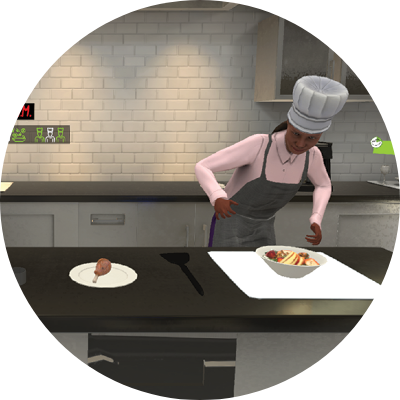 Loading...
Loading...
Initial language selection is based on your web browser preferences.

10MB
Free
In this simulation, students work as chefs and manage a busy service with multiple tasks competing for their attention. As orders come in, they must choose which actions to take, which to delegate, and how to handle unexpected disruptions. Time is limited and teamwork is essential, making organization and decision-making key to completing the job. In this module, students practice assertive communication with kitchen staff while working under pressure. Through realistic scenarios, they also practice planning, taking the lead, and handling disagreements – skills essential in hospitality and other collaborative roles. **Key features:** - Focuses on organization, time management and communication under pressure - Builds teamwork and conflict resolution through delegation and decision-making - Based on authentic kitchen scenarios and roles ## Course Content: This course is one module. ## Duration & Guidance: All modules are approximately 10-15 minutes in duration, but times may vary depending on the user. We recommend that this experience is best undertaken standing, although a seated experience is possible. ## Module: Executive Chef{.objective .objective1} In this module, students practice assertive communication with kitchen staff while working under pressure. Through realistic scenarios, they also practice planning, taking the lead and handling disagreements – skills essential in hospitality and other collaborative roles. ## Learning Objectives: 1. Demonstrate time management and task prioritization in a kitchen setting{.info} 2. Communicate assertively and professionally with team members{.info} 3. Apply delegation and conflict management skills to complete a shared goal{.info} # TEACHING FRAMEWORK FOR VOCATIONAL PATHWAYS{.objective .objective} # Before the Experience **KWL Chart** Activate prior knowledge and prepare students for what they will see in VR simulation. Students will fill in the K (What I Know) and W (What I Want to Know) sections, while the remaining section will be completed post-experience. - Identify three things that you already know or think you know about the industry, technology, tools used and/or careers.{.task} - Write two questions about what you want answered or are curious about.{.task} # During the Experience **Tech Lab Journal** To support engagement and learning during each VR session, ask students to maintain a Tech Lab Journal. This journal can be a small notebook, a stapled packet, a digital document or use the worksheet provided (see exemplar for further guidance). The Vocational Pathways Worksheet Exemplar draws on the Welding and Intro to Construction simulations as detailed case studies. While these examples focus on specific experiences, the model student responses are representative of reflections, observations, vocabulary and presentations expected across all of the Vocational Pathways content. After completing each VR session, students should take a few minutes to reflect and add to their journal, noting the date and which lesson they completed. Other suggested journal entries may include: - Key Vocabulary – Identify new terms and/or technical language that was introduced, along with definitions for each. - Sketches or Diagrams – Create simple sketches of tools, systems, processes, and/or machines students interacted with, along with labels for the whole and its parts. - Notice and Wonder – Take note of interesting moments or surprising results students noticed, as well as questions they are curious about. These should be written as “I noticed...” and “I wonder ...” statements. # After the Experience **KWL Chart** To follow up, ask students to complete the L (What I Learned) section, reflecting on what they learned during the session. - Identify at least three things that you learned about the industry, technology, concepts or career.{.task} # Extended Learning **Job Quest: Explore an Entry-Level Career Role** Students are then encouraged to continue their learning by researching what an entry-level position in this career field looks like. This exploration makes learning more personal and purposeful, helping students consider future career opportunities. Even if they decide this career is not a good fit, the process builds career awareness, critical thinking, and allows the student to take ownership of their learning. Ask students to research the following: - Job Description - Tools and Skills Needed - Education and/or Training Needed - Salary and Job Outlook - Work Environment Ask students to create a visual summary of their research. Consider giving them a choice to create a slide presentation, one-pager, infographic, short video, or use another appropriate presentation method. # Reflection Ask students to write a reflection. Based on their VR experience and research, would they consider this career? Why or why not? # How To View Student Analytics 1. Login to the [Xennial Teacher Portal](https://xrplatform.xennialdigital.com/home) 1. Results can be viewed based on the name the student entered For full set-up instructions, including video walkthroughs and support documents, please visit our support pages [ClassVR Support](https://www.classvr.com/)